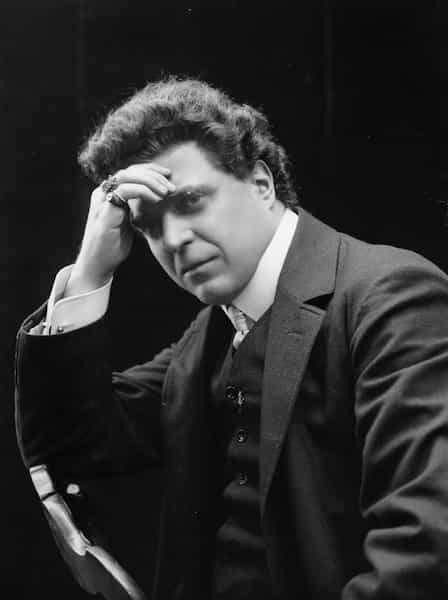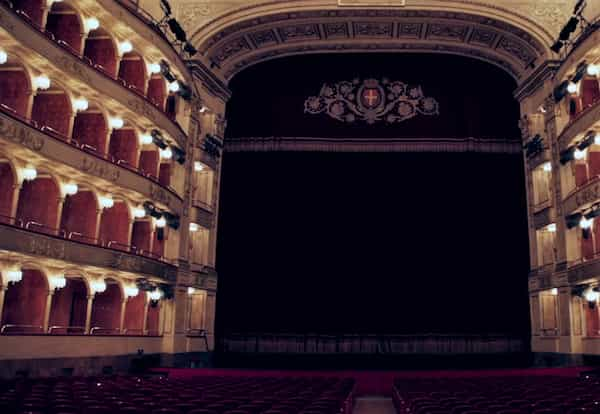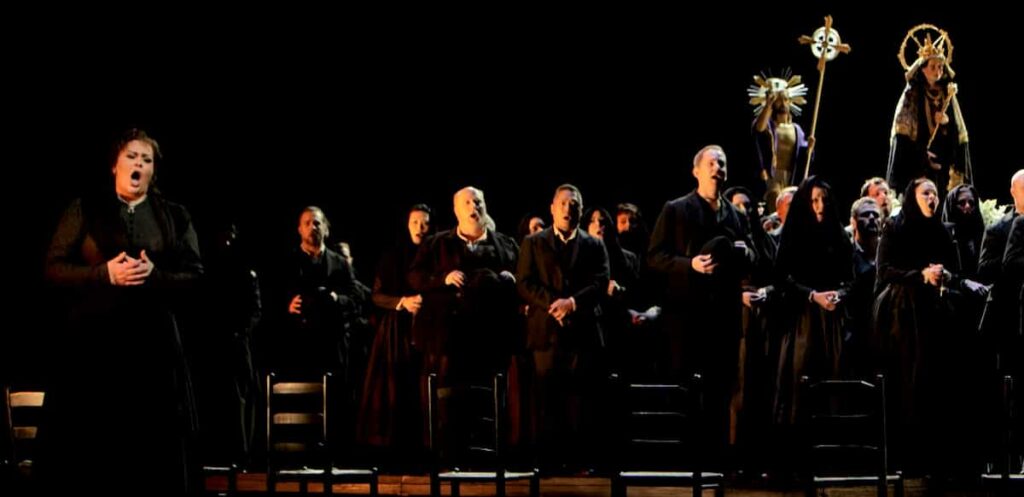Cavalleria Rusticana
Mascagni’s masterpiece.
In 1880, the short story Cavalleria Rusticana was published in the Sunday edition of Il Fanfulla. The usage of a colored and extended version of the paper on Sundays was a very popular treat. And many high-profile writers were invited. Verga, who was born in Catania, Sicily, and who knew the rural usages of the big island very well, included all this knowledge into his Cavalleria Rusticana. It was later included in Verga’s book, Vita dei campi published a year later. And it was transformed into a one-act play by the writer himself.
In 1888, the Milan publisher Edoardo Sonzogno announced a competition open to all young Italian composers who had not yet had one of their works performed. The task was to write a short opera, in one act only. Mascagni was only 25 and living in Cerignola in Puglia at the time, conducting the local band and teaching. Cerignola was very far from the buzzing Milano music stage, and he came to know about the competition only a few months before the deadline.
He asked his friend Giovanni Targioni-Tozzetti to write a libretto, but to do it fast. And it was actually he who came up with the idea of Cavalleria Rusticana. Mascagni finished it in time, writing the final part on the day before it was supposed to be submitted. The rest is a fairytale. The opera was chosen to be performed at the new opera in Rome, and it was a sensational success. From there Mascagni’s life turned around. From being an unknown band leader in an Italian outpost, he turned into a celebrated composer whose fame reached far beyond the Italian borders.

Premiere – May 17, 1890, at the Rome Opera House (Teatro Costanzi), Italy
Composer – Pietro Mascagni
Librettists – Giovanni Targioni-Tozzetti and Guido Menasci
Running Time – Around 1 hour and 10 minutes
One Single Act
Overture 6 minutes.
In Italian
Main characters
Santuzza, young village girl: Dramatic Soprano (Mezzo-soprano). More about her voice here.
Turiddu, young man, a soldier just back from the front: Lyric-Dramatic Tenor.
Lola, Alfio’s wife: Mezzo-soprano.
Alfio, a carter: Baritone.
Lucia, Turiddu’s mother: Contralto.
The opera is based on the short story and the one-act play Cavalleria Rusticana by Giovanni Verga.
Download this short Pdf-guide. Print it, fold it, and keep it in your pocket as a help when you’re at the Opera. Please keep your phone turned off when inside the theater.
Cavalleria Rusticana is often combined with another one-act opera to make up a full evening performance. For many years the standard combination was with Pagliacci by Leoncavallo, but lately, other one-act operas or ballets are used more frequently.
A short background to Cavalleria Rusticana.
There are a few things about Verga’s story that you do well in knowing before the curtain rises. As said, Verga was very knowledgeable about the Sicilian way of life. The short story is full of details about old customs, and rural ways of life, in language as well as events. The title means rustic chivalry and it is actually right on spot. As an example, when Alfio challenges Turriddu at the end, Verga has them giving each other the duel embrace. But Turiddu then bites Alfio’s ear compelling him to show up.
 The story is told in one single day, but to understand what’s happening we need to look back a year. And to do that we have to read the story by Verga.
The story is told in one single day, but to understand what’s happening we need to look back a year. And to do that we have to read the story by Verga.
A year before the day of the opera, Turiddu was engaged to marry the beautiful Lola. But he was called to the arms, and when he came back, Lola had married the older and much richer Alfio… Supposedly for the money. Turiddu was furious and started courting all the young girls in the village just to get back at her. In a particular way he was making out with Santuzza. Not only because she was very rich, young, and willing, but also because she lived in front of Alfio and Lola. (Verga changed her origins to much more humble ones already in his play. In the opera, she is portrayed as poor.)
The trick worked, and jealousy grew in Lola. She started to imagine Turiddu, young and handsome instead of the old Alfio in her chambers. And so their old love story came to life again. But that left Alfio, who often was away on business, and Santuzza, who unfortunately became pregnant after a nightly encounter with Turiddu, hanging.
And that’s where the opera starts…
The opera Cavalleria Rusticana is set in…
Vizzini, a small inland town on the big Italian island. The time is contemporary, that is, the second half of 1800.
For those who have some knowledge about southern Italy and their way of life a hundred years ago, the events should be familiar. But it could have been staged in any rural context, where honor is a major treat. Where religious practices and traditional values complicate every thing.
Verga’s text could seem innocent on the surface, but scratching a little a totally different picture shows. A picture where lost honor is much worse than death, and where the wrong word or the wrong gesture in the wrong situation can cost you your life. The opera is full of small details that instead of being innocent remarks, are truly life-threatening, as it should be in a verismo opera.
Would you like to visit Sicily?
Would you like to see the sites where the Opera takes place?
Plot
First, there is a beautiful and very effective Ouverture, which incorporates Turiddu’s first aria, a serenade for Lola in Sicilian dialect sung off-stage. it’s accompanied by a solo harp.
– O Lola ch’hai di lattl la cammisa. (Lola, your blouse is white as milk…)
The words refer to something in Verga’s story. Red and white as cherries, meaning white as in indifferent and red as in excited.
At the end of the serenade, the overture continues.
The curtain opens and we see the villagers preparing for the feast of Easter day. The first sound from the orchestra are chimes playing a perfect fifth. A very typical church bell sound. The chorus sings:
– Gli aranci olezzano…
Everybody’s happy, Life is good…
But there’s a short scene where Santuzza comes to talk with Turiddu’s mother Lucia. It is very obvious that the old woman doesn’t care much for Santuzza as she’s just another of the many girls roaming around her son. Santuzza asks her for Turiddu, and she answers that he is gone to Francofonte, the neighboring village to get wine. But Santuzza says…
– No he was seen here last night…
But still, he hasn’t come home. Lucia asks Santuzza to step inside. but she refuses.
– … Sono scomunicata! (… I am excommunicated)

It doesn’t mean that literally, but she is telling us about her huge shame. The only thing that can save her is if Turiddu should marry her.
Now Alfio enters and sings his famous aria:
– Il cavallo scalpita… (The horse canters… But when I come home, Lola’s there waiting for me.)
Alfio too has seen Turiddu in town, close to his own house in fact. Mother Lucia is upset by this but is silenced by Santuzza.
The desperate situation.
There is another beautiful and pompous chorus praising the Lord on Easter day. It is sung by two full choruses, one off-stage. Lucia and Santuzza join them singing:
– Inneggiamo, Il Signor non è morto… (Let’s sing, the Lord is not dead…)
When everybody has left the square, Santuzza finally explains to Lucia the truth of the situation… About Turiddu and Lola.
– Voi lo sapete, oh mamma…
She tells the old woman to pray for her. She will await Turiddu to implore him one last time.
So, he arrives, and they talk. It is evident though that Turiddu doesn’t really want to chitchat. He sees no meaning in discussing. He is deprecatory, but she insists. She says he’s been seen in the neighborhood at Alfio’s house.
– Alfio told us so just now…
And that is dangerous for Turiddu. He takes it out on poor Santuzza, who is prepared to forgive anything as long as he comes back to her. As they quarrel, suddenly Lola arrives.
Lola
– Fior di Giaggiolo… (The iris flower… Of all the angels in heaven none is more beautiful than him…)
Santuzza is overwhelmed by jealousy:
– Today is Easter day… And the Lord sees every thing…
Lola replies:
– Are you not going to mass?
– I’m not going… Only she who is free from sin should go…
– Io ringrazio il Signore e baccio in terra. (… I kiss the ground meaning, I salute you with respect and deference… )
– Oh, you do well in doing so…
Lola slowly glides away towards the church while the two follow her with their eyes. But the connection between Turiddu and Santuzza has reached a new low-water mark. Turiddu is scared that Santuzza could reveal his affair with Lola to Alfio, and Santuzza is terrorized that he could abandon her for good. So, at the end she again tries to implore him in the short but very powerful duet:
– No, no, Turiddu, rimani rimani ancora… (Please, Turiddu stay, or will you abbandone me…?)
A perfectly awesome cast: Franco Corelli, and a wonderful Grace Bumbry.
They leave each other in anger. And Santuzza now completely desperate throws a curse at him:
– A te la mala Pasqua… Scongiuro! (An evil easter for you…)
And that is an immensely strong thing to say in a 1800 catholic Sicily. It means death, like Jesus died on the cross…
Alfio
Unfortunately, the one person she doesn’t need at that moment arrives. … Alfio. And in her furious state, she spills her guts and tells him everything in a short but intense sequence.
Alfio shakes her and says:
– Se voi mentite, vo’ schiantarvi il core! (If you’re lying, I will crush your heart!)
Then he sings a short melody:
– Ad essi non perdono! Vendetta avrò pria che tramonti il dì. (I can’t forgive… I will have my revenge before evening.)
… And, Santuzza realizes that she could have signed Turiddu’s death sentence then and there.
Intermezzo
Mascagni decided to separate the tragic finale from the beginning. He wanted the audience to be able to take a breath and calm down somewhat, and he does it with a beautiful short orchestra interlude. This is probably the most famous of all the music in the opera. It is very often played at concerts as a separate piece.
The conclusion
The villagers come out from the church after mass and the music from the beginning is picked up with the chimes and all. The chorus sings a short piece about how the day is finished and they are heading home…
Lola and Turiddu are among the others and Turiddu asks them to join him in a toast. Everybody joins in when he sings his second aria:
– Viva il vino spumeggiante…

When Alfio arrives you need to listen carefully. Their exchange of words is brilliant… Turiddu says:
– You must drink with us!
– Thank you, but I do not accept your wine…
– As you wish…
And Turiddu throws out the wine he poured for Alfio before he continues:
– Do you have more to say?
– Me, nothing.
– Then I am at your service…
– Now?
– Now!
They embrace and Turiddu bites Alfio’s ear. Now Turiddu sings a short but very significant phrase:
– I know I am in the wrong, and if it was just for me, I’d let you cut me down like a dog. But I have to provide for Santuzza. If I don’t live, she has nobody.
Turiddu runs home to get his knife, but before he walks out again, he sings his last aria to his mother:
– Mamma… Quel vino è genroso… (Mamma, the wine is too strong… Promise me, if I don’t come back, be like a mother to Santuzza…)
The opera finishes with a female voice shouting at the top of her lungs:
– Hanno ammazzato compare Turiddu!! (They’ve killed Turiddu!!)
Things to look out for.
Turiddu’s serenade inside the Ouverture – O Lola ch’hai di lattl la cammisa
8 minutes – Dite, mamma Lucia… The short scene with Santuzza and Lucia.
11 minutes – Il cavallo scalpita. Alfio’s aria.
14 minutes – Inneggiamo, il signor non è morto. The two choruses and Santuzza worshiping the Lord.
21 minutes – Voi lo sapete, oh mamma. Santuzza tells Lucia about her son and Lola.
27 minutes – Tu qui, Santuzza? Turiddu and Santuzza argue in the square.
36 minutes – No, no Turiddo... Santuzza implores him one last time.
38 minutes – A te la mala pasqua. At the end of the scene Santuzza curses Turiddu.
Immediately after – Santuzza tells Alfio about his wife and Turiddu.
Immediately after – Ad essi non perdono! Alfio swears vengeance.
44 minutes – Intermezzo
————————-
50 minutes – Viva il vino spumeggiante! Turiddu’s drinking song.
55 minutes – Alfio arrives.
60 minutes – Mamma… Quel vino è generoso. Turiddu’s last aria.

Something about the voice of Santuzza.
Santuzza is labeled Soprano. But if you check out modern productions she is almost always sung by a Mezzo-soprano. The reason is that the role has a low Tessitura-Average range. And, the orchestra throughout the whole opera is fairly thick with a full sound, which is more difficult to penetrate for the lighter voice.
Some of the greatest Santuzza throughout its performance history has been what is called Soprano Falcon, named after the famous French soprano Cornélie Falcon. This is a type of Dramatic Soprano who apart from a strong voice, also has good middle and lower register. They are sometimes described as Mezzo-soprano and Soprano, or Soprano Sfogato. After all these labels and classifications, more or less useful, what it comes down to is a strong voice not only in the top register but on the low notes as well… e.g. a Mezzo-soprano. The color should be fairly bright though, as she is a young girl.
Another interesting fact is that Maria Callas debuted as Santuzza in a student production at the Olympia theater in Athens. She was 15 years old.

Italian Verismo
Cavalleria Rusticana is considered the first ever Verismo opera, from Vero meaning true, real. It would take someone more learned than me to be able to describe all the subtle differences between positivism, naturalism, realism, and verism. One thing that is clear though, is that while realism and naturalism were more French in their expression, verism definitely was an Italian form, closer to realism than to naturalism.
Mascagni grew up in a very new Italy, where conflicts were huge… Between rich and poor, men and women, city and countryside, and most of all, between southern Italy and northern Italy. Right after the foundation of the new nation in 1861, the political winds blew from the right, like in many of the other European countries. But at the time of Cavalleria Rusticana’s premiere, Italy had turned, I wouldn’t say left, but at least liberal.
Vergas was a true verista, and his text oozes of verism. In the later decades of the century his crude description of a Sicily in stagnation, deprived of its previous wealth and culture was eagerly consumed not only by the southerners but even in Rome, Milan, and Livorno, Mascagni’s hometown. So, when Mascagni found himself in front of the newly written libretto, he probably just tried to compose as well as he could. And in doing so, he not only created a masterpiece that would fill the opera houses for centuries to come, but he also invented a whole new school of composing. All that at the age of 27.
Other verismo composers are Ruggero Leoncavallo, Francesco Cilea, Umberto Giordano, and to some degree Giacomo Puccini.
Download this short Pdf-guide. Print it, fold it, and keep it in your pocket as a help when you’re at the Opera. Please keep your phone turned off when inside the theater.